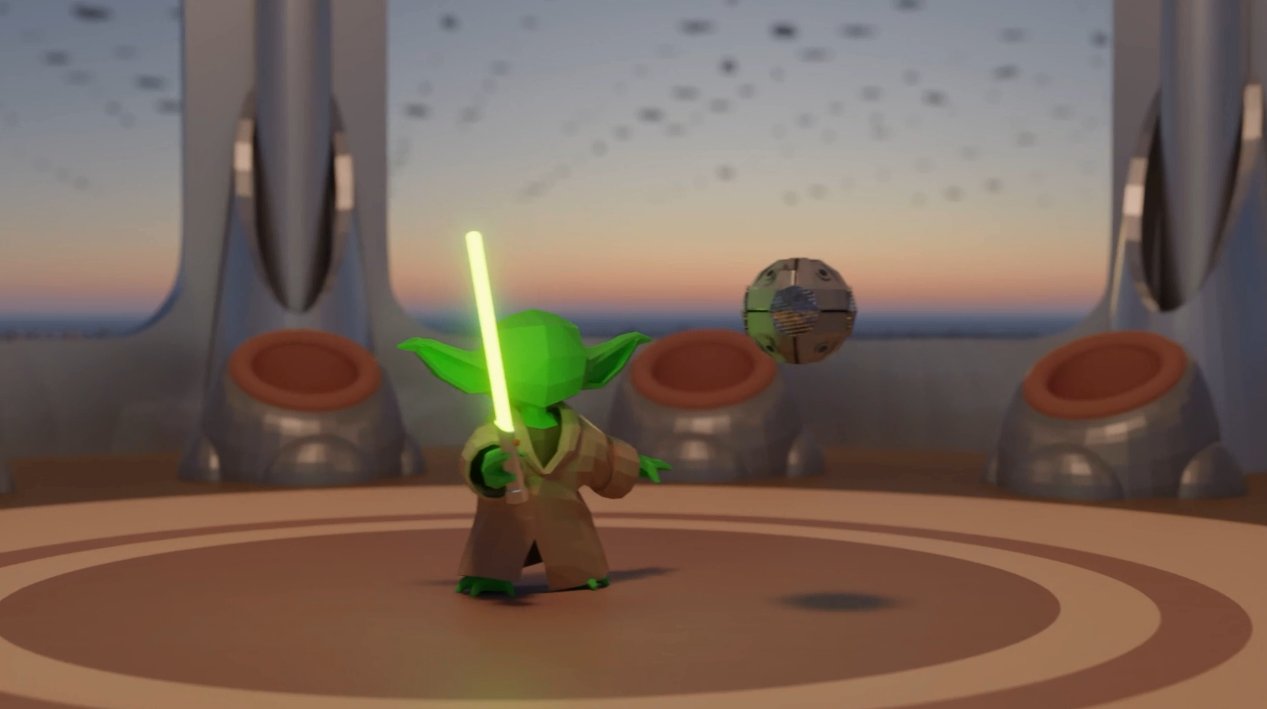In the distant planet Coruscant, Master Yoda enjoys practicing his Jedi art alone in the high council chamber. He is assured concentration, peace and discretion here. But, no matter how great of a Master he was, he did not notice that a curious and stealthy fly aspired to become a Jedi. Let’s name her Myia.
During the great Master’s practice, Myia will carefully observe the movements of the lightsaber. Myia is still a young fly and her visual cortex is not mature. It is messy.
But here is Yoda’s first move. He turns his sword to the right, in a fast and powerful movement. At the same time, in a column of Myia’s visual cortex specializing in the detection of orientations, a neuron activates.
It is the one that, in this precise moment, reacts most strongly to the direction of the lightsaber. The six neurons in its vicinity also activate. They then adapt to becoming a little more sensitive to the orientation shown by the lightsaber. The lesson continues and so does the adaptation process.
As time goes by, it is no longer six nearby neurons that are adapting, but four, then two and then only the one that reacts the strongest. Watch the animation to find out what is going on in one of the columns of Myia’s visual cortex.
What happened in the column of Myia’s visual cortex following this observation session?
Messy at first, her column was organized in such a way that any pairing of neighboring neurons became sensitive to two orientations in close proximity. The neuron sensitivities in the column of the visual cortex are now organized. This is not the product of a directed action: it is the result of an emergence.
![]()
Sensitivity to orientations before self-organization

Sensitivity to orientations after self-organization
You have just experimented with an absolutely fundamental principle based on an extremely simple procedure taking place in three phases: perception and dissemination of a signal, the search for a winner, and the adaptation of the winner and its neighbors. And so, as part of a series of strictly local changes you end up getting a global order. It is the self-organization of neurons on perceived visual stimulations.
If curiosity tickles you, you could even try to do this with arrows engraved on pebbles. This will work just as well and avoid Myia’s additional training sessions with Master Yoda.
Why is this important for our quest of artificial intelligence? In a collective book published in 2003, Scott Camazine (Camazine, et al., 2003) reveals the key: “one of the mysteries of biology is how the enormous amount of morphogenic, physiological and behavioral complexity of living organisms can be achieved with the limited amount of genetic information available in the genome. Self-organization is a solution to this problem.”
The three-phase procedure and an algorithm used to experiment with the emergence of an order by self-organization, was proposed in 1982 by a Finnish researcher: Teuvo Kohonen. (Kohonen, 1982). He bridged the gap between the universal principle of the biology of living things and the possibility of making it appear into an artificial system. We will come back to this in a future article, as the scope of the applications it opens is so vast.
Let us stay for a moment on the consequence of what we have simulated, which is called: retinotopy.
The definition of retinotopy is that two similar stimulations perceived by one eye triggers responses from two nearby neurons in the visual cortex. We could sum it up as ” visual stimulations that are similar, come together.”
At the end of our simulation with the Kohonen algorithm we get a retinotopy by self-organization.
Retinotopy is found in the brains of all mammals, including humans, but also in birds (Keary, Voss, Lehmann, Bishof, Lwel, 2010) and insects (Franceschini, 2008).
But what is probably most remarkable is that what applies to the visual system applies to all types of stimulation. We will talk about tonotopy for sounds, somatotopy for parts of the body, chemoreception for smells, and gustatory senses for taste.
You understood it: external and internal sensory modalities are mapped.
This mapping is built in large part by the perceived stimulations: movement, sounds, smells, taste. Their richness and variety are essential for fine mapping.
We have just experimented it: it is possible to bring out sensory maps by the sole mechanism of self-organization. This self-organization that we are able to simulate with a computer thanks to the work of Kohonen.
Do you see the doors that this link opens for us?
In his remarkable book (Damasio, 2010) Antonio Damasio sheds light on the meaning of cortical maps: “the human brain is a born cartographer and this mapping begins with that of the body in which it is installed. The human brain is an imitation of this incoercible variety. Everything outside of it […] must be imitated within its network.” Put another way, each brain is a uniquely condensed to the perceived world.
I will meet you for our next article in which we will continue our exploration of the secrets of self-organization.
Works cited
Camazine, S., Deneubourg, J.-L., Franks, N., Sneyd, J., Theraulaz, G., and Bonabeau, E. (2003). Self-organization in Biological Systems. Princeton University Press.
Damasio, A. (2010). The other one myself. The new brain maps of consciousness and emotions. Odile Jacob pockets.
Franceschini, N. (2008). Color and movement in the life of an insect. CNRS Interdisciplinary Thematic School, (pp. 56-80). Mr. Roussillon.
Keary, N., Voss, J., Lehmann, K., Bishof, H.-J., and Lwel, S. (2010). Optical Imaging of Retinotopic Maps in a Small Songbird, the Zebra Finch. PLOS One.
Kohonen, T. (1982). Self-Organized Formation of Topologically Correct Feature Maps. Biological Cybernetics, 43, 59-69.
